
How to Choose the Best Kitchen Floor
No matter your budget, we’ve got plenty of options. From laminate and wood to tile and vinyl, we have everything you need to finish your floors. Check out our most popular flooring options and find the best kitchen floor to complete your dream.
When redoing a kitchen you might think the important choices are your appliances or kitchen cabinets, but if your floors can’t handle the heat, you might have to get out of the kitchen! Make sure to start with the best kitchen floor so the next time you’re whipping up your favorite dish, floor maintenance will be the last thing on your mind.
There are a few types of flooring you might be considering for your kitchen: laminate, engineered wood, hardwood, tile, or vinyl. What you choose probably depends on your budget and your goals for your kitchen. Ideally, you want a floor that meets all your needs, especially if you’re like me and live in the kitchen (because that’s where bread and cheese is.)
What do You Want in a Kitchen Floor?
- Low-maintenance: Nobody wants to spend most of their time cleaning floors. For this reason, the best kitchen floor will be easy to maintain. Liquid spills shouldn’t make us sweat, that’s what the stove is for! A kitchen floor should be easy to spot clean or mop in no time.
- Affordability: Flooring doesn’t have to break the bank, and shouldn’t. Affordability allows you to have the beautiful flooring you want, but with enough cash left over to buy that Kitchen-Aid stand mixer you’ve been eyeing.
- Look: Looks matter! Perhaps your kitchen needs a modern look, or maybe your Pinterest is full of vintage on-trend floors. Whatever your look, you need a flooring with the versatility to achieve it.
- Durability: The cost of replacing floors is extra money you don’t want to spend, so you want a floor that can withstand the heat and last a lifetime—or at least decades! The kitchen is the home of heat, spills, and mess. If your floor can’t take it, you might find yourself having to replace it early. Start with a flooring that’s durable so you can love it longer.
Let’s Find the Best Kitchen Floor
Decided what qualities make up the best kitchen floor? Let’s begin!
Related Content >> The Best Waterproof Flooring Options
Hardwood Floors for Kitchens
Let’s start with hardwood. Hardwood floors will never go out of style. It is the definition of a classic look. Hardwood will give a warmth to your kitchen and comes in virtually any finish you can think of. Not only that, if you ever want to update your kitchen, you can simply sand and stain your floors to match your updated look.
However, as great as hardwood floors are, they are the most expensive option of flooring for your kitchen. Though hardwood is known for its durability in high-traffic areas, it is not known for its ability to withstand water, heat, and humidity—all things a kitchen is prone to.
Pros of Hardwood Floors for Kitchens
- Won’t go out of style: Your kitchen will never look tacky or out-of-date. You might one day regret your chevron wallpaper, but you will never regret your hardwood floors.
- Durable: Hardwood is great for high-traffic areas, and you can choose your thickness for even longer durability!
- Can be refinished: Depending on the thickness of your hardwood, you can sand and refinish them for an updated look, without having to replace the whole floor.
- Great for open floor plans: If you have an open floor plan, hardwood is your friend. You can use hardwood in your kitchen and living room for a seamless transition from one room to another.
Cons of Hardwood Floors for Kitchens
- Changes in temperature and humidity can harm floors: As durable hardwood floors are, moisture is not their friend. Changes in moisture and humidity can result in warping or even gapping in your floors. You can combat this with a moisture barrier, but that adds to the cost.
- Can be difficult to clean: Remember that thing I said about moisture? You definitely want to make sure your mop leaves no standing water on your flooring.
- More expensive option: Hardwood is beautiful! But it comes with a cost. With additions to protect your kitchen floors against moisture, you may find your flooring costs more expensive than intended.
- Installation type is limited: Because hardwood is moisture-prone, you can only install it over a plywood subfloor at or above ground level. If you buy a thinner hardwood, you may glue it over concrete, but it will have less durability in the long run.
Related Content >> Wood Flooring Trends
Engineered Wood Floors for Kitchens
To be honest, engineered wood floors are my favorite, so excuse me if I am biased. First, engineered wood flooring can be installed literally anywhere. Well, maybe not literally, but in most places!
Second, it features real hardwood but can stand up to moisture and humidity much better than the real thing so your kitchen won’t kill it. Not only that, but it is less expensive than hardwood. Do I have your attention now?
Pros of Engineered Wood Floors for Kitchens
- Durable– Engineered floors are made of many layers that keep them durable over time. It features a scratch-proof finish (good if you’re prone to dropping heavy objects like me), real hardwood, a core layer for durability, and a backing layer to battle moisture. It’s basically an all-in-one flooring.
- Real wood, but the inexpensive alternative– You don’t have to lie to your friends—it really is real wood! It looks like real wood because it is real wood. Let your friends be jealous of your wood floors knowing you spent less.
- Easy to clean, easy to change– Because of its backing, you don’t have to worry about moisture as much when cleaning your floors. No need to fret about a little liquid. Not only that, when you’re ready to change, you can also refinish these floors for a new look! Just be sure your hardwood layer is thick enough, first!
- Easier to install than hardwood– Because it can be installed anywhere, you don’t have to worry about your subflooring. You can nail, staple, glue, or even float engineered wood floors.
Cons of Engineered Wood Floors for Kitchens
- Refinishing is limited– Because you have a wood layer and not a solid hardwood, you are limited to the number of times you can sand and refinish your floors. Bummer.
Laminate Floors for Kitchens
What is this laminate you keep hearing about? It’s all over Pinterest, it’s on HGTV, and most of your friends are installing it on the weekends. Truth is, laminate is taking flooring by storm. It’s a great, inexpensive flooring option if you have a tight budget. It’s durable, easy to install, and comes in a variety of finishes.
However, there’s a downside; It doesn’t feature any real-wood. Upside? It looks like real wood! It can also look like other materials too– like stone. A high-resolution image is adhered to the top of the plank, giving it a gorgeous, natural look at a fraction of the price.
Pros of Laminate Floors for Kitchens
- Inexpensive: Laminate flooring is the most inexpensive option for your kitchen. Not only that, but since you can easily install it yourself, you save money. If you choose this option, you’ll definitely have money left over for those new cabinets.
- Easy to clean and maintain: Because of its multi-layer construction, laminate is very easy to clean and maintain. Laminate is typically made from high-density fiberboard and is resistant to water. It also features a backing that will keep water from soaking through to the flooring underneath. You won’t have any worries while cleaning your floors.
- Easy install: Laminate flooring is the easiest to install, why else are your friends doing it on their weekends? Laminate flooring is designed to be a floating floor and is built with special locking mechanisms to easily be inserted and “locked” in place. Easy-peasy!
Cons of Laminate Floors for Kitchens
- Less durable than hardwood: Since it doesn’t feature any real wood, it’s not going to be as durable as hardwood. Yes, it’s more water-resistant, but it will garner more wear and tear over the years than hardwood floors.
- Look depends on the quality of laminate: Laminate flooring comes in all types and finishes! However, a real-wood look comes with a more expensive price-tag. For a real-wood look, you will need a thicker laminate plank, with wood-like grooves scratched into the surface to fool the eye. This will separate the inexpensive laminate from the more expensive laminate planks.
- Cannot refinish floors: Because laminate is an image, you cannot refinish your floors. This means when it’s time for a change, you will need to buy all new flooring.
Related Content >> Laminate vs Vinyl Flooring
Tile Floors for Kitchens
Kitchen floor tiles are a booming industry. One reason being tile can look like just about anything these days, even wood! Tile is also durable and the easiest option to clean. Kitchen floor tile is either ceramic or porcelain, and your options on looks and price will depend on which one you pick. Here are the deets:
Ceramic has the least amount of options as far as looks but is the lowest price-point in the tile market. It typically mimics the look of wood or natural stone like limestone and everyone’s favorite, travertine. Don’t worry, you’ll still have plenty of options with ceramic.
Porcelain, on the other hand, is the wizard tile that can look like just about anything, including fabrics and even marble. Yes, I said fabrics. With this many options, you’re likely to find your perfect kitchen floor tile.
Pros of Tile Floors for Kitchens
- Not gonna wear: Whatever you choose, ceramic or porcelain, tile will not wear like other options will. Water has no power here.
- Perfectly on trend: Have you seen those beautiful large porcelain tiles in the kitchen? Wide tile is trending, with good reason– it makes your kitchen look bigger! If style and durability are your top criteria, tile is the way to go.
- Choices: With tile, you have plenty of options at any price. Ceramic is an inexpensive option for kitchen floors, while porcelain is the more expensive tile. However, porcelain can mimic just about any material these days, and you’re sure to find the texture and material-look you want.
Cons of Tile Floors for Kitchens
- Installation is difficult: With tile, you can’t glue, staple, or float your floor; you use mortar. This process can take a while and can leave a mess. For installation, you will need a variety of tools including mortar, spacers, and sealers. Make sure you’re adequately prepared for this process.
- Your subfloor needs to be GREAT: You can install over plywood (preferably exterior-grade), concrete, and full-contact vinyl flooring. If installing over concrete, take precautions to avoid cracking in the tile due to swelling subfloors. For the best install, you might need to do some pre-work and make sure your subfloor is level or consider hiring a contractor
- Ceramic and color: Ceramic flooring is made of clay, fired in a kiln, and then glazed with a pattern or color. This means the look you chose is only on the surface, and not underneath. If your ceramic tile ever chips (which is rare, but hey, it might happen) then the natural clay color will certainly show. Fortunately, porcelain shows less sign of wear because the color or pattern is all the way through the tile.
Related Content >> Commercial Kitchen Flooring: 4+ Ideas for Your Restaurant
Luxury Vinyl Floors for Kitchens
I’m excited to tell you about this option; it is definitely one of my favorites! First, the lowdown. Vinyl flooring comes in a variety of different options: rolls, tiles, and planks. Rolls are the least expensive, but are mostly used in large areas and require professional installation. For the purpose of the home kitchen, let’s focus on tiles and planks.
Planks and tiles can be installed in a peel and stick method, glued down, interlocked and floated, or loose lay. How you install might determine what type of vinyl you want to purchase.
Peel and stick vinyl offers a great temporary flooring, but we wouldn’t recommend it for permanent use. Both planks and tiles come disguised as wood, stone, or other decorative patterns. There are so many options to choose from!
Related content >> Vinyl Flooring Trends
Pros of Luxury Vinyl Floors for Kitchens
- Installation Choices: You can peel and stick, glue (permanently), lock and float, or loose lay. You’ll never have more options than with vinyl.
- Trendy and beautiful: You might not realize it, but most of the floors you’ve been admiring on Pinterest are probably vinyl. Vinyl is making a comeback, and with new technology making vinyl beautiful and more durable than ever, I believe it’s a well-deserved one. Your dream kitchen has a look, and vinyl can help you achieve it.
- Looks: Stone, wood, or patterns. The choice is yours.
Cons of Luxury Vinyl Floors for Kitchens
- Expense varies: Depending on what type of luxury vinyl purchased, it can be expensive. Though it’s still less can some porcelain and engineered wood, it can be more expensive than laminate.
- Phthalates: Don’t ask me how to pronounce this, but I do know phthalates can be a concern. Phthalates are being researched as links to health problems, and you might feel better minimizing your contact with them. Good news is there are plenty of phthalate-free options.
WPC Vinyl Floors for Kitchens
The crème of the crop for vinyl flooring is WPC (wood plastic composite AKA waterproof core) flooring because it is 100% waterproof. No more wondering what moisture-resistant or water-resistant labels mean because WPC is definitely waterproof.
I’ve stressed before how wood flooring can be risky in a wet, messy area like the kitchen. Worry not! WPC Vinyl is here to offer the best of both worlds. Believe me, this is not-your-father’s vinyl flooring. This may be the best kitchen floor money can buy. Don’t believe me? Check out this cool video where we soak WPC in red wine!
Pros of WPC Vinyl for Kitchen Floors
- Installation heaven: Have an uneven subfloor? No problem. Want to glue down tiles? You got it. In the mood for self-adhesive or a locking, floating floor? The choice is yours. You are the master of your floors and can install it however you want.
- Waterproof: Let me say this again: WPC vinyl is 100% waterproof. How does it work? WPC has four layers of goodness. The top is a wear layer, which keeps your floors looking nice. Second is the luxury vinyl top layer, where your image is. It’s durable, resilient, and resists chips and dents. Third, you have the core structure of WPC: where the magic happens. The third layer is waterproof, high density, and will not expand or contract. The fourth layer is the underlayment— you won’t be needing a separate one. All this means it’s easy to clean, too!
- Looks: Stone or wood? Whatever fits your fancy.
Cons of WPC Vinyl for Kitchen Floors
- Expense varies: WPC is the best vinyl flooring out there, and it comes with an expense. Though it’s less expensive than most porcelain tile and real hardwood, it’s more expensive than laminate flooring. However, the expense may be worth it for waterproof floors.
- Phthalates: Good news! While some laminate and vinyl still contain phthalates, our WPC is all phthalate-free.
Related Content >> What is WPC Vinyl Flooring? Top 10 Things to Make You a WPC Expert
Which One Do I Think is the Best Kitchen Floor?
Now that you know the ins-and-outs of the kitchen flooring world, which one is best for you?
If you have a high-budget and you want the highest quality floors in your kitchen, hardwood floors are the way to go. They are durable and create a classic look in your kitchen, plus your friends will be jealous.
If you want to save money and have beautiful floors, laminate and ceramic tiles are durable and come in a variety of finishes to complete your dream look. Kitchen floor tiles are always a classic look.
Personally, I love engineered wood flooring. Engineered wood has the characteristics of hardwood, but with more durability in the kitchen and less expense. Plus, you still get bragging rights for having real wood in the kitchen.
You say you want style? Then porcelain is for you. It’s the trendiest tile around right now, and nothing can compete with its modern look.
All that said, the best kitchen floor may be WPC vinyl flooring. You simply can’t beat its 100% waterproof rating, and its got style, too. It can handle dropped pots and quick spills and you don’t have to worry about the mess. Take it from a food fanatic and experienced mess maker— you want WPC vinyl floors in your kitchen.
Whatever you do, love what you choose, and get cooking!
Related Content >> Kitchen Flooring Trends











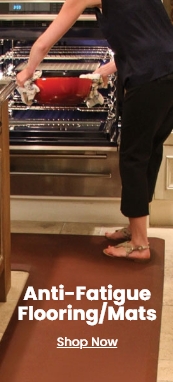

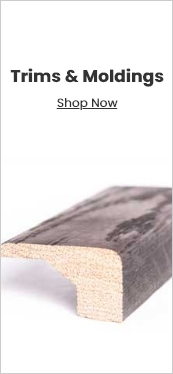


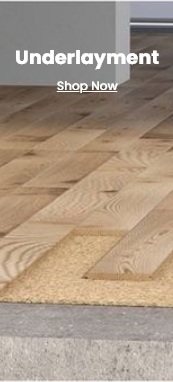


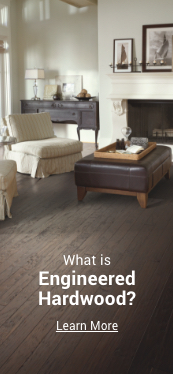

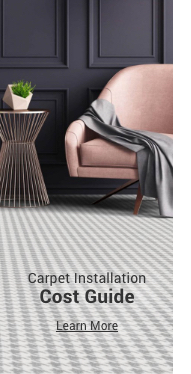
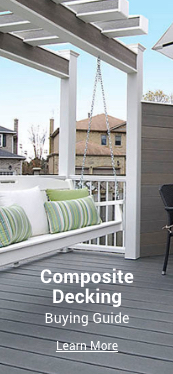


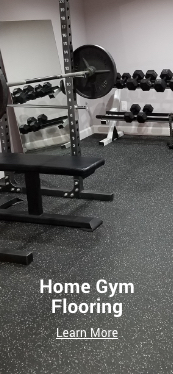

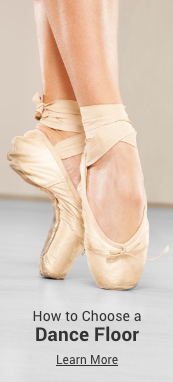
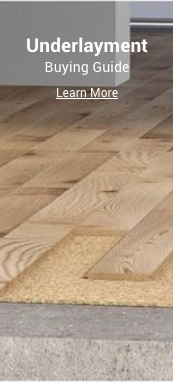

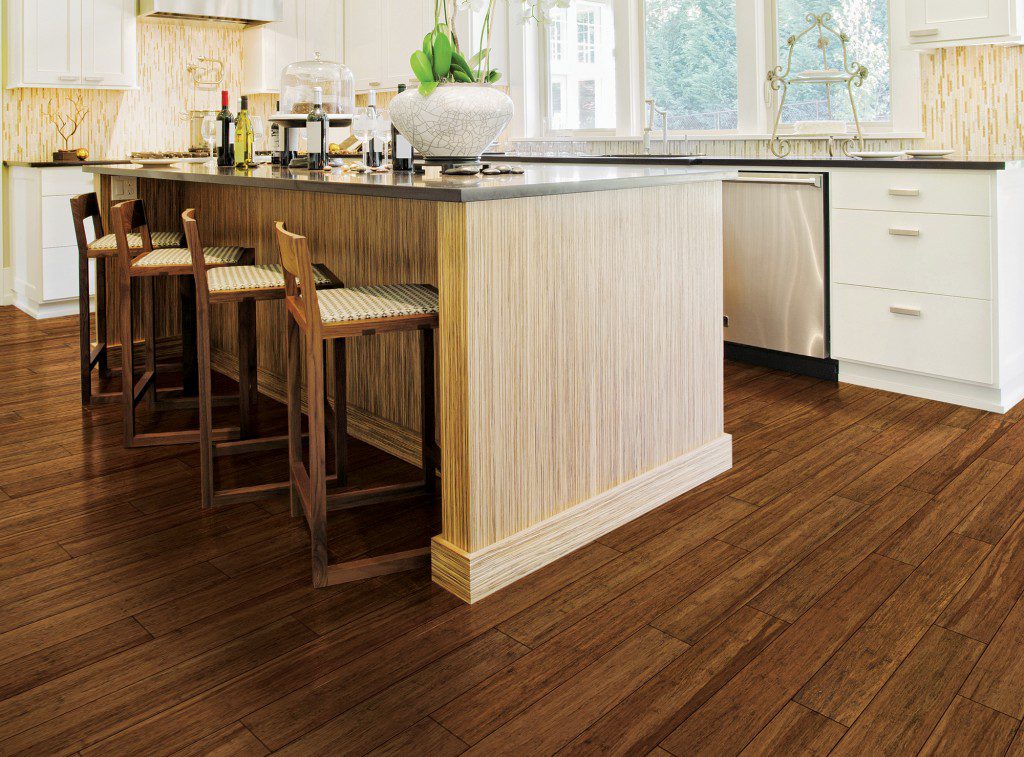
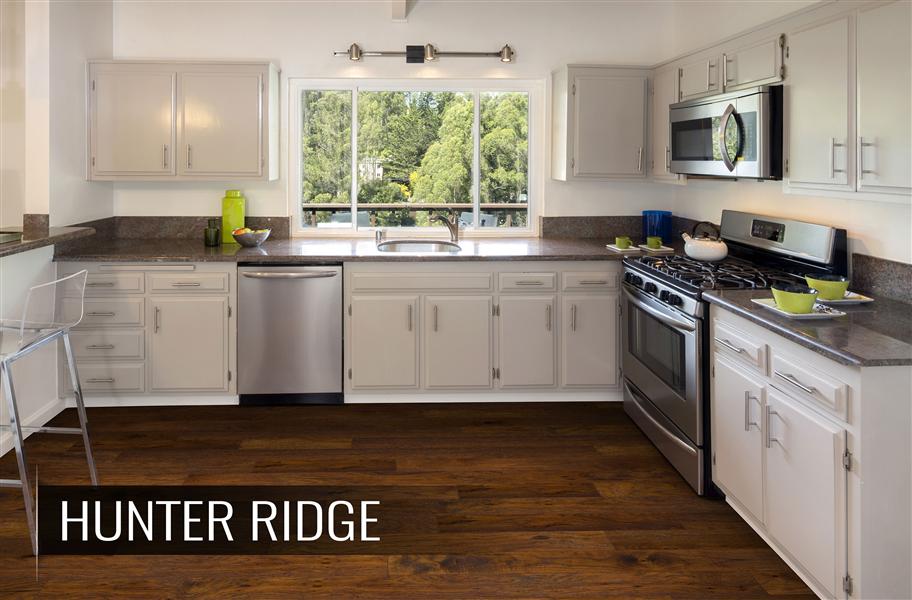
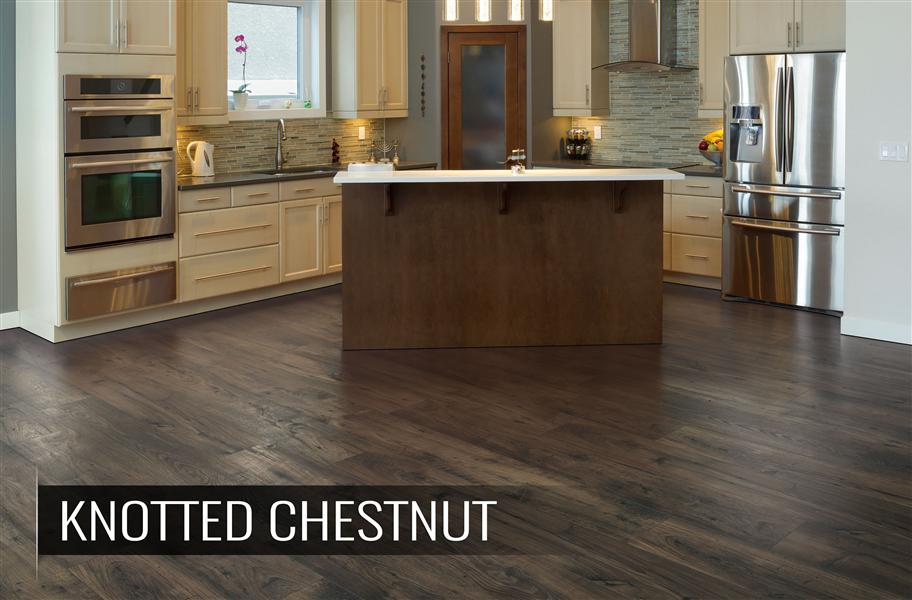

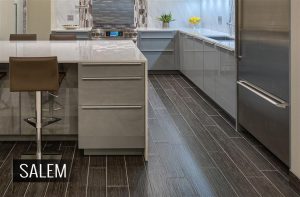
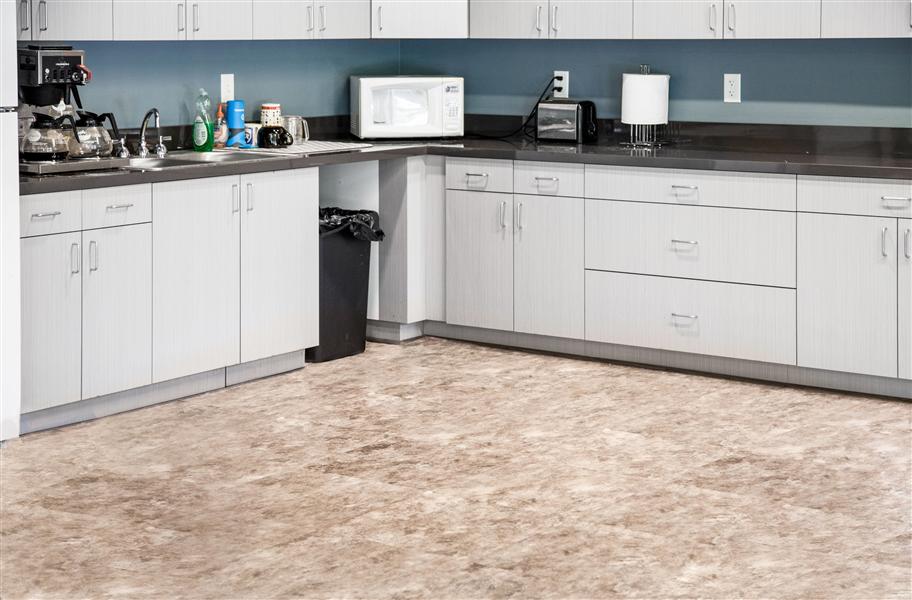
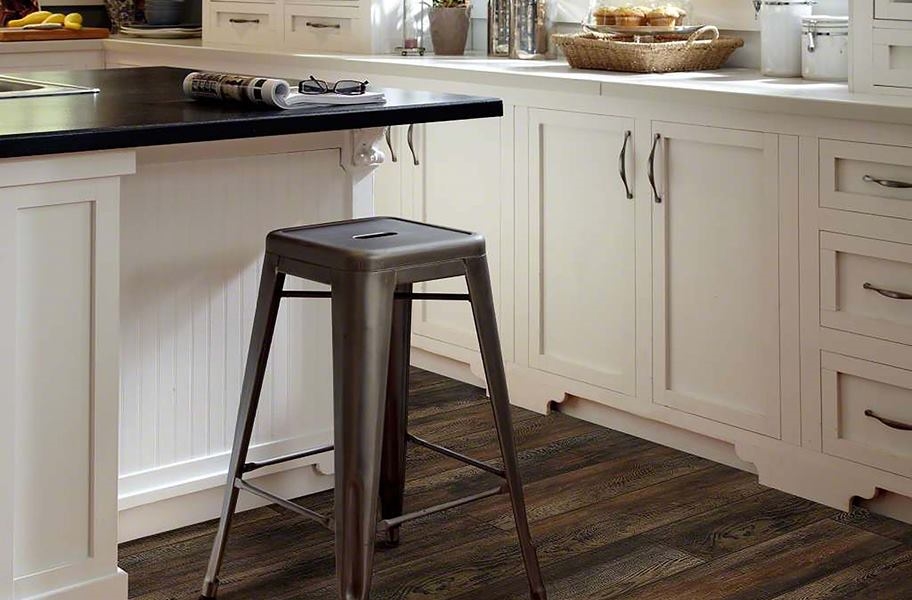
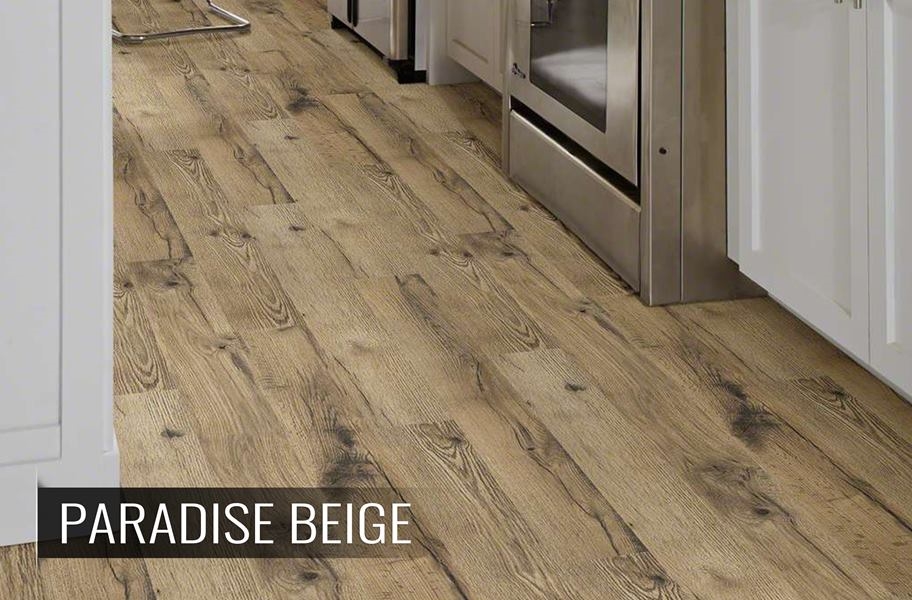
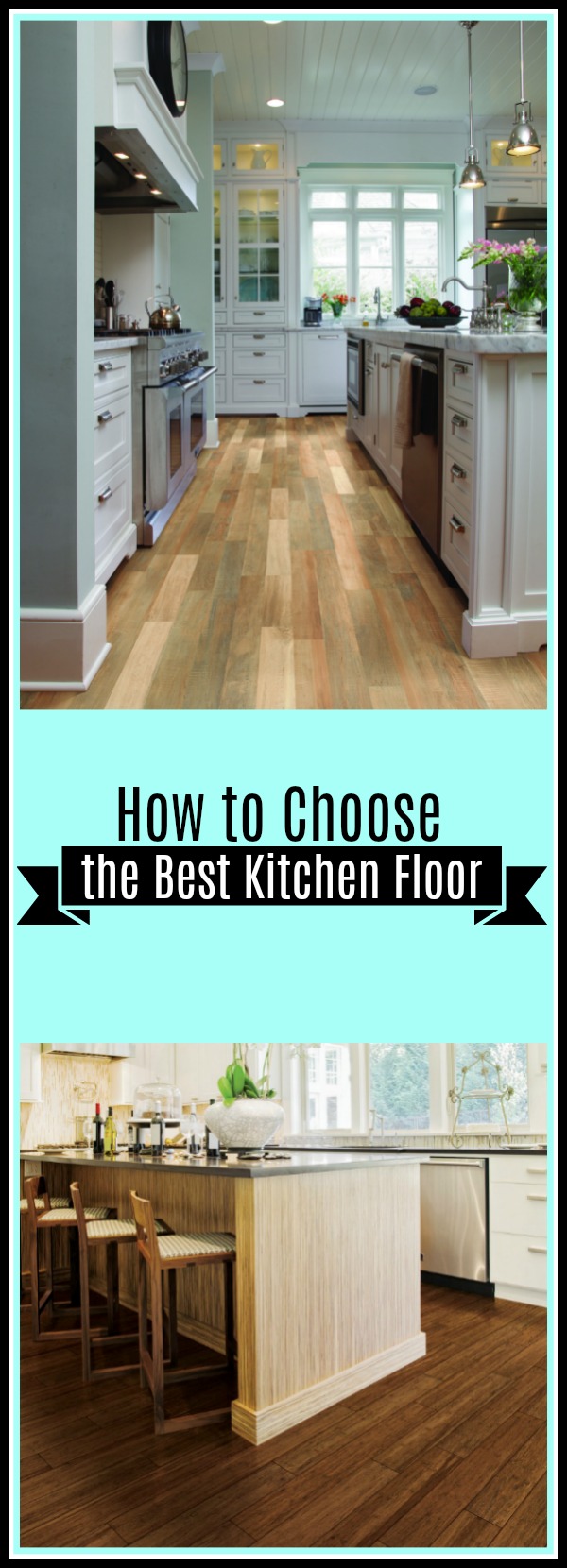


I like how you say that vinyl flooring is completely waterproof and has a layer that’s made to keep it looking good. My kitchen’s floor is cracked, and I’ve never liked how it looks anyway. Your tips should help me find the right type, and I’ll just need to find someone who can install it for me.
Thanks, Amanda! Good luck with your new kitchen floor!
We’ve been looking into getting some porcelain flooring for our bathroom. I’m glad you talked about how porcelain offers good style and is very trendy, which I think would be good. I’m going to have to look for a good porcelain flooring option for us and see what we can find!
Sounds like a great plan, Jordan! Let us know if you’d like us to set you up with any free samples. Good luck with your bathroom!
My wife and I are planning to put a new floor in our kitchen and we are having trouble deciding what kind of flooring to install. I really liked the engineered wood, especially since it will be easy to clean and I am not patient with cleaning our house! I will be sure to recommend engineered wood to my wife for our kitchen.
Thanks for the information on finding the right flooring for a kitchen. I had never considered engineered wood flooring, and I think you made a great point about its durability in the kitchen without costing nearly as much as hardwood. I love the hardwood look but don’t want to spend quite that much on my floor so I think I’ll have to look into this. Thanks!
Recently I am planning for wood flooring at my home. I was little confused about the flooring type for kitchen dining and the other room. Well, after reading the pros and cons, I have decided to install engineered wood for my kitchen and for other area I will prefer hardwood floor installation. The elegant look of hardwood floor is very impressive.
Hi John,
Sounds like a great choice! Glad you found this helpful. Good luck with your project!
Vinyl flooring is becoming so popular these days – it’s by far the biggest seller in the industry here on the east coast of Australia. Agreed that other types of flooring has its own positives and negatives, but I highly recommend vinyl for the kitchen!
I agree. It’s a great alternative for clients who simply don’t have the funds for other flooring types like hardwood.
Thanks for pouring your sweat and making this article. I really love the way you explained each Kitchen flooring option. Your tips are helpful !!!
Thanks for sharing informative information with us. As per my experience engineered wood floors is the best options for kitchen.
The kitchen flooring is the foundation which your kitchen literally rests. By failing to give more consideration to your flooring options and selecting the wrong flooring will insure that an otherwise outstanding kitchen will look only average, and become dated sooner.
Have to say the way you have described the most sought of flooring material for kitchen along with their pros & cons seems very valuable. There is no doubt that all the above-stated materials have something to offer when it comes to the kitchen floor as well as your preferred Engineered wood floor too. But, we do believe that natural stones such as marble are still most sought out material to lay.
At last, a very informative post to read…
Thank you!
You’ve got great tips for choosing the right flooring. I love how you said that we need to decide what we want. I think low-maintenance and durability are our two priorities. With those in mind, we’ll be able to pick just the right floor!
Excellent!
It got me when you said that laminate and ceramic tiles are durable with different types of finishes and styles. With that in mind, I will choose this for the flooring of my kitchen since it will be able to withstand the activities there. Like one time, I dropped a metal pan on the floor so it might have damaged the flooring that is why it must be strong enough to handle it.
I like that you say that hardwood floors will never go out of style. My brother and his wife are building a new home this summer and want to have the best materials for their house. I will send them this information so they can start looking into hardwood flooring services to help them out.
Wonderful, thank you!
Thank you for sharing such a informative blog on kitchen flooring
Hey! exactly they are durable and create a classic look in your kitchen, plus your friends will be jealous.
Thanks for explaining that hardwood floors are popular because they don’t go out of style. My husband and I want to get new flooring for our home soon. Your article made me excited to do some more research about hardwood flooring.
Thanks for mentioning that hardwood floors never go out of style. My husband and I are renovating our kitchen this summer, and I want to ensure our design choices will hold up as trends change. Hopefully we can find some great hardwood flooring in our area!
Good luck, Shayla!
My wife and I have been looking to replace the floors in my mom’s old home before we sell it, so it could look nice. It would be very important for us to stick with our budget. I really appreciated that you mentioned that flooring doesn’t need to break your budget. When we replace the floors, I will be sure to look for some that will be affordable.
Thanks, Jeff! Good luck with your project!